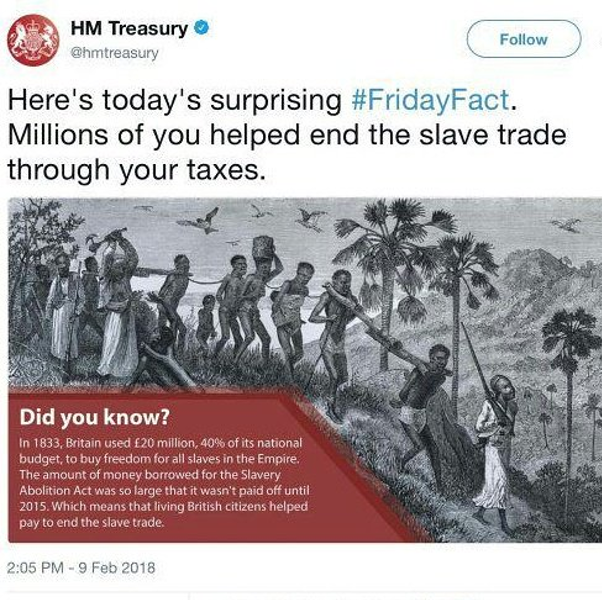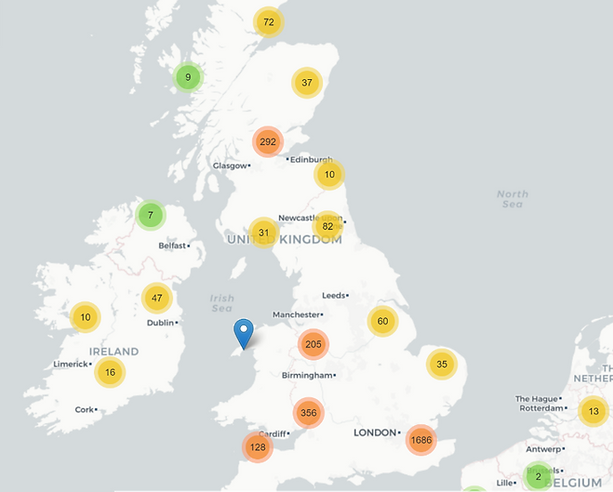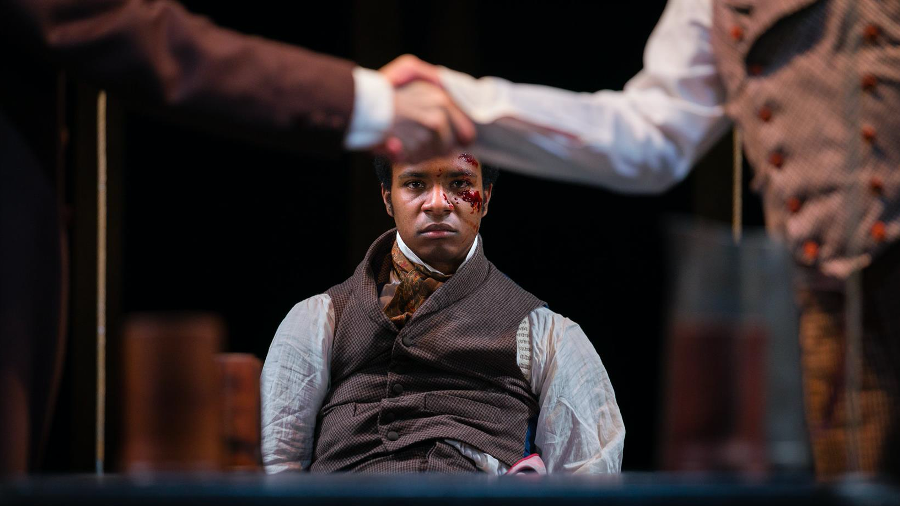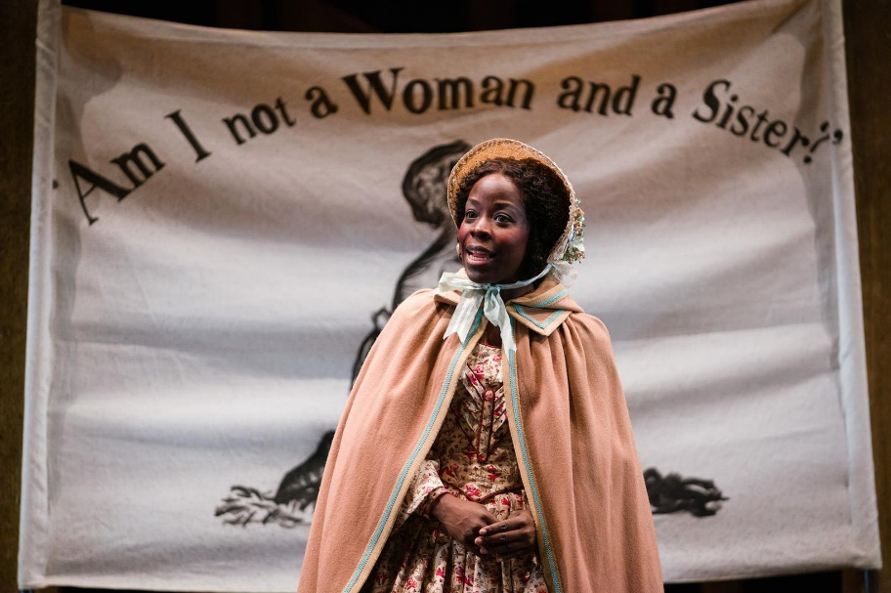The Royal Shakespeare Company’s latest production, The Whip, offers a thoughtful interpretation of the complex network of activist groups, political agendas, and private interests that were woven into the passage of the British slavery Abolition Act of 1833.
The Royal Shakespeare Company’s latest production, The Whip, offers a thoughtful interpretation of the complex network of activist groups, political agendas, and private interests that were woven into the passage of the British slavery Abolition Act of 1833. The play asks the audience two questions: “What is the right thing to do, and how much must it cost?”

It is unsurprising that the play revolves around questions of ethics and morals (’the right thing to do’), but it also addresses practical concerns and socio-economic consequences – i.e. the cost of freedom. The Abolition Act itself intervenes not merely as the dénouement or climax of the play, but almost as a fatal blow. The spectators both desire and expect it from the start, but they come to dread it – as the escalation of ambition, political hubris and entangled personal destinies transform the Act’s realisation into a bittersweet conclusion.
The 1833 Abolition Act has been central to a certain narrative of Britain’s role in slavery: that it was the first Western country to abolish slave-ownership. Britain abolished slavery before France (1848), the United States (1863), or Brazil (1888), but after Spain (1811) and a lot of newly-independent Central and South American states.[1]
Yet slavery – and the slave-trade – had already been undermined by decades of conflict between European nations and the slow ‘swing to the East’ of colonial and imperial ventures in the nineteenth century. In many ways, this play revisits and dramatizes what had been at the heart of Eric William’s Capitalism and Slavery (1944): that Britain’s modern wealth and society had been made possible by centuries of slave trade and plantation-based colonial economy, and that the latter labour system was simply no longer economically profitable when slave-ownership was finally abolished.[2] By the time the international slave trade itself had been abolished in 1807, Britain as a single country had transported 3.1 million Africans (of whom only 2.7 million survived the Atlantic Middle Passage) to the British colonies and to other countries across the Caribbean, North and South America.[3] With the slave trade gone, and planters left to ensure their slave populations would live long enough to ensure demographic growth, the case for the substitution of a poorly paid and wage-bound workforce gained momentum.
The play introduces a series of semi-historical characters, all meant to symbolically embody different ends of the debate. The lead character, Lord Alexander Boyd, a fictional Whig Party Chief Whip, portrays a man with good intentions but little follow-through. Acting as the eponymous character of the play (The Whip), Boyd embodies the close connections between the destinies of the peculiar institution and Westminster’s politics, despite their apparent geographical remoteness. A shrewd and popular politician, he is tasked by fellow Party members to lead the charge to pass the Abolition bill, and gradually realises how pervasive slavery has become to British society. The entanglement of slave-derived wealth in British society is revealed through the limited set of characters, all members of parliament living rather comfortable lives among elite circles. However, to research further, one only needs to browse through UCL’s compelling Legacies of Slave-Ownership (LBS) website to see the extent to which slave trade and slave-ownership, in addition to wealth coming from the Caribbean, accelerated the growth of the British middle class.

The database compiles 5,090 addresses linked to 5,426 individuals. Only 3,267 of these addresses appear on the map so far, because some are much further afield than the British Isles. In Oxfordshire itself, which in 1841 totalled 163,000 inhabitants, 18 claimants came forward – three of them linked to the colleges of the University. Yet many more claimants were Oxford or Cambridge alumni. Throughout the 17th and 18th centuries, the largest portion of Oxford’s international students had come from the former thirteen colonies and from the West Indies, establishing very direct financial connections between the Atlantic world and the growing wealth of the University’s colleges. When browsing records according to the claimants’ education, at least 241 of them had attended Oxford, and 190 Cambridge. Although by the 1830s many members of the British society condemned slavery on moral grounds, and would not have admitted to owning slaves – personified by one of the play’s characters Lord Maybourne, who claimed “having never set foot in the Caribbean” – a great number of them came forward when the Abolition Act was announced.
Why such a sudden desire to come clean and admit to slave-ownership? Because the 1833 act also very generously compensated the former slaveholders – that is, for their loss in property. Property rights had been considered paramount ever since Lockean theories became an essential feature of Britain’s legal language and philosophy in the early 18th century, at the very same time when Britain’s involvement in the Triangular Trade gained momentum.[4] As such, the Abolition Act deprived a significant – and potentially powerful – portion of British society of what they considered to be one of their most sacred rights: compensation was due. This compensation amounted to £20 million in 1833, about 40% of the Treasury’s income and 5% of its GDP. In modern-day value, this sum would be almost £20 billion.[5] This national debt was only completely reimbursed in 2015, after almost two centuries of taxpayers’ contributions.[6] It is little wonder that the promise of such riches would bring many slave-owners out of their anonymity and have them turn their drawers upside down to retrieve the documents evidencing their legal possession of claimed slaves.

But what about the slaves in this story? Two of them appear as distinct characters in the play: Mercy Pryce – inspired by real Mary Prince, a runaway slave and abolition advocate – and Edmund, another young runaway who had become Boyd’s ward. Edmund’s character is said to have been inspired by 18th century abolitionist Olaudah Equiano, who had spent some time as the slave of a Royal Navy Officer. Equiano later bought his freedom before becoming a prominent member of the activist group ‘Sons of Africa.’ In the play, Edmund’s character portrays an individual at the threshold of revolt. He is torn between his loyalty to Lord Boyd, his benefactor who taught him how to read and write, and the feeling of indignation that, despite all his merits, he did not receive proper remuneration for his labour and was treated as a second-rate citizen. To some extent, Edmund’s destiny offers an insight into the aftermath of emancipation. In British colonies, former slaves underwent a seven-year unpaid and unsupervised ‘apprenticeship’ period. In many other colonies, metropoles, and independent states, former slaves faced unequal citizenry and systemized discrimination that had its roots in the decades of racial justification for human bondage.


Mercy Pryce, on the other hand, shines as the true lead character of the play. A mixture of Mary Prince (real-life British runaway slave and abolitionist, who was actively involved in the campaign leading to the 1833 Act) and U.S. born Sojourner Truth (a contemporary anti-slavery speaker, whose words ‘Am I not a Woman and a Sister’ appear on a banner during the play), Mercy diffracts the many components of the debate onto the brutal reality of slavery: violence, abuse, and dehumanization. Knowingly used by politicians, she also uses the politicians’ ambitions for her own ultimate purpose: abolition. Compensation can be agreed to as a means to an end, yet the ultimate victory of West Indian planters’ demands for a prolonged state of apprenticeship abruptly disillusions Mercy as to the state of the rights of men, women, and children in Britain. And this is probably where the play succeeds most astutely in offering a transversal, intersectional approach to the question of abolition: by tying it to the wider emergence of a capitalist society, in which human beings, if born in the wrong household, are increasingly treated as a commodity. She teams up with Boyd’s housekeeper, Horatia Poskitt, whose daughter perished in a cotton mill in the North of England. This allows the play to bring forward a dense network of social and historical references, from the rapid and ruthless industrialization process in Britain and the promulgation of disenfranchising ‘Poor Laws’ (of 1834, which introduced workhouses and paternalistic approaches to workers’ rights), to child labour legislation (e.g. in 1856, children of 9-16 years could legally work for up to 60 hours per week, night or day), and womens’ suffrage campaigns. The female friendship that develops between Mercy and Horatia, and the understanding of the similarities between struggles that they had first thought irreconcilable – abolition on the one hand, and labour law reforms on the other – act powerfully over the audience, displacing dividing lines and categories in order to better understand the structural character of oppression.

The play is ambitious and mostly succeeds in offering a complex and nuanced portrayal of the wider context surrounding the abolition debate, including both the discussions that agitated the British public and the international setting in which they were taking place. Yet, once again, the play falls into the trap that many accounts of abolition have gravitated towards: to give an account of abolition from the viewpoint of Europe, and to suggest that it started in political chambers. The two individualized former slaves are compelling characters, yet the immense number of enslaved men and women are reduced to a mute chorus, observing almost speechlessly, from the side-lines, the debate that is unfolding on the other side of the ocean. This overlooks the innumerable daily acts of disruption by slaves, and the rebellions – and even revolutions – that took place, time and again, since the beginning of the slave trade and the plantation system. Enslaved people have been agents of resistance and active participants in the abolition of the so-called “peculiar institution” – and abolition, in Britain as in many other European nations – happened, to a great extent, because of this indefatigable opposition. It was not simply bestowed upon the colonies by conniving politicians.[7]
You can see The Whip at the Swan theatre, Stratford upon Avon, until 21 March 2020.
Written by Olivia Durand
References:
[1] France had abolished slavery for the first time in 1793, and subsequently re-established it in 1802 (as Napoleon desperately attempted to regain control over revolutionary Saint Domingue/ Haiti, France’s most profitable sugar island). It was abolished again in 1848. It must also be noted that Spain abolished slavery in the context of its own struggle to keep control over its American colonies, hoping for loyal support of the emancipated slaves.
[2] On Eric William’s work, read Emma Gattey’s blog post: “Capitalism and Slavery: the view to and from Oxford.” [3] Portugal and Britain were the two most ‘successful’ slave-trading countries accountingfor about 70% of all Africans transported to the Americas. Between 1525 and 1866, in the entire history of the slave trade to the New World, according to the Trans-Atlantic Slave Trade Database, 12.5 million Africans were shipped to the New World. 10.7 million survived the dreaded Middle Passage, disembarking in North America, the Caribbean and South America.
[4] In 1713, Britain had obtained an asiento contract, becoming the sole provider of slaves to Spanish America until 1750. During these three decades of monopoly, Britain shipped about half a million slaves. Britain only outlawed international slave trade after the loss of its main landed colonies in North America, and in the context of international maritime competition with other European powers – thus creating a pretext to attack other ships for their transportation of slaves after 1807.
[6] The final reimbursement of the debt was only highlighted by a tweet from HM Treasury’s account three years later. The framing of the tweet itself gave rise to a lot of debate, as it perpetuated the idea that Britain’s abolition of slavery was essentially a humanitarian act, devoid of political and financial calculations.
[7] Further readings on slave resistance: Laurent Dubois, Avengers of the New World: The Story of the Haitian Revolution (Cambridge, Mass., 2004) Robin Blackburn, The American Crucible: Slavery, Emancipation and Human Rights (London, 2011) Phillipe R. Girard, The Slaves who Defeated Napoleon (Alabama, 2011) David Brion Davis, The Problem of Slavery in the Age of Revolution: 1770-1823 (Cornell University Press, 1975) Christopher Leslie Brown, Moral Capital: Foundations of British Abolitionism (Chapel Hill, 2006)





